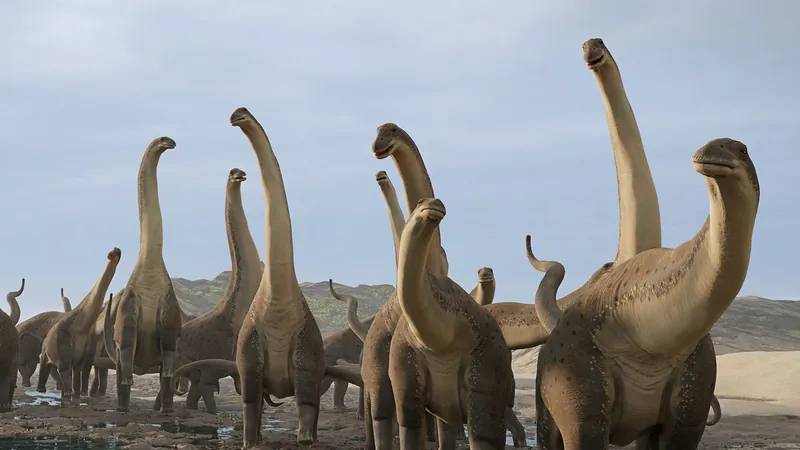
The Titanosaur Family: Giants of the Cretaceous Era
2025-01-09
Author: Yu
Introduction
Imagine a creature so massive it could dwarf entire buildings; that was the titanosaur, one of the most colossal land animals to ever tread Earth. Roaming during the Late Cretaceous period, approximately 100 million years ago, titanosaurs belong to a diverse family of sauropod dinosaurs noted for their enormous size, lengthy necks, and remarkable adaptability.
Fossil Discoveries
The fossilized remains of these herbivorous giants have been unearthed across various continents, offering glimpses into their mysterious past. Their name derives from the Titans of Greek mythology, reflecting the monumental scale of their existence. As one of the last sauropods before the cataclysm that wiped out the dinosaurs, titanosaurs exemplify evolutionary success, resulting from their adaptability to diverse habitats.
Distinctive Features
Unlike their sauropod relatives, titanosaurs evolved distinctive features, including long necks designed for reaching high vegetation and whip-like tails that likely served multiple purposes, from balance to defense against predators. Their tremendous weight was supported by column-like legs, while their smaller heads housed peg-like teeth, perfect for stripping leaves efficiently.
Defensive Adaptations
Interestingly, many titanosaurs were also equipped with armor-like bony plates, known as osteoderms, embedded in their skin, which provided an extra layer of defense. This adaptation highlights their vulnerability, reinforcing the idea that even the mightiest of dinosaurs had to contend with predators.
Size Diversity
Though often imagined as towering giants, titanosaurs displayed immense diversity within the family. Their sizes varied significantly; while some members like Argentinosaurus and Patagotitan reached lengths comparable to modern multi-story buildings, others, like the smaller Saltasaurus, were just '20 feet' long, showcasing the broad spectrum of physical forms within this fascinating group.
Variety of Species
The titanosaurs were not merely a single species but comprised a rich variety of closely related dinosaurs. Recent discoveries, such as Patagotitan mayorum unearthed in Argentina, provide insights into their biology and ecology during the Cretaceous period. While larger titanosaurs thrived in rich environments, smaller species adapted to terrain requiring different defense mechanisms, showcasing evolutionary strategies across a range of ecological niches.
Origin of the Name
The term 'titanosaur' originated from a British paleontologist's misinterpretation in the late 1800s when he named a skeleton Titanosaurus indicus in India. Although deemed to represent a non-new species, this artifact inspired the broader naming of the entire family.
Social Behavior
Fossil evidence suggests that titanosaurs were social animals, likely living in herds for safety. Fossilized trackways indicate collective movement, possibly migrating toward favorable grazing areas while providing protection for the young from predators like the theropods of the era.
Parental Care
Additionally, these massive creatures exhibited significant parental care, as seen in fossilized nesting sites where females laid numerous eggs in shallow pits, frequently returning to the same localities. This repeated use of nesting grounds suggests a stable social structure and a commitment to safeguarding their offspring.
Diet and Feeding
The titanosaurs' diet primarily consisted of vegetation such as ferns, cycads, and conifers. Their long necks allowed them to graze effectively, while their specialized teeth adapted them for their plant-based diets. The titanosaurs' unique digestive systems were likely fermentation chambers, allowing them to process tough plant materials over extended periods without the need to feed constantly.
Habitat and Climate
During their reign, Earth had a vastly different climate, characterized by warm, tropical conditions and abundant vegetation. Titanosaurs roamed diverse landscapes, from South America to Africa, Asia, and even Antarctica, thriving in rich ecosystems shaped by shifting tectonic plates.
Challenges of Size
Despite their size offering several advantages, life for titanosaurs presented its challenges. They inhabited floodplains and forests rich in food resources, but these areas also attracted predators, necessitating herd behavior and unique adaptations for survival.
Growth and Maturity
The journey of a titanosaur began in an egg roughly the size of a soccer ball, astonishingly small for such a giant creature. Hatchlings started at just a few feet long but displayed remarkably rapid growth, gaining hundreds of pounds in their first year to evade predation effectively. This accelerated growth rate marked one of the fastest observed among dinosaurs, underscoring the urgency of reaching a size able to fend off threats.
Lifespan and Challenges
As titanosaurs matured, they faced fewer predatory dangers, but their immense size imposed distinct physical stresses. Fossil evidence suggests they lived for several decades, balancing their colossal frames against the challenges of their environment. Injuries, resource scarcity, and other environmental changes may have significantly influenced their lifespan, contributing to the intricate web of life that characterized the Late Cretaceous period.
Conclusion
The mythos of titanosaurs continues to captivate our imagination, embodying the enduring mystery of a world rich in diverse and awe-inspiring life. Discoveries and studies of these remarkable creatures provide a window into a lost era, reminding us of Earth's incredible evolutionary journey.



 Brasil (PT)
Brasil (PT)
 Canada (EN)
Canada (EN)
 Chile (ES)
Chile (ES)
 Česko (CS)
Česko (CS)
 대한민국 (KO)
대한민국 (KO)
 España (ES)
España (ES)
 France (FR)
France (FR)
 Hong Kong (EN)
Hong Kong (EN)
 Italia (IT)
Italia (IT)
 日本 (JA)
日本 (JA)
 Magyarország (HU)
Magyarország (HU)
 Norge (NO)
Norge (NO)
 Polska (PL)
Polska (PL)
 Schweiz (DE)
Schweiz (DE)
 Singapore (EN)
Singapore (EN)
 Sverige (SV)
Sverige (SV)
 Suomi (FI)
Suomi (FI)
 Türkiye (TR)
Türkiye (TR)
 الإمارات العربية المتحدة (AR)
الإمارات العربية المتحدة (AR)